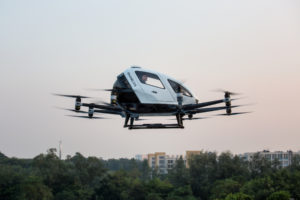
China-based EHang, the passenger drone company that went public last year, has announced first quarter results. Despite the global pandemic, EHang showed year over year revenue growth. The company is also broadening it’s applications: in addition to emergency response operations revealed in the current crisis, EHang recently received certification from the Chinese government for cargo delivery trials.
Among the business highlights listed in the report were several important benchmarks for EHang’s passenger drones:
- In January 2020, EHang achieved a new landmark, conducting the first-ever flight in the United States of a passenger-grade AAV. The EHang 216 flight was performed in the state of North Carolina, which is known in aviation history for the Wright Brothers initial flight there a century ago. EHang’s AAV flight was underpinned by permit and other support from the North Carolina Department of Transportation (NCDOT) and the U.S. Federal Aviation Administration (FAA).
- In February 2020, EHang 216 obtained the first operational permit in Europe for flight testing of an AAV from the Civil Aviation Authority of Norway, laying a solid foundation for future UAM operations in other European countries. Furthering its penetration in Europe, in March 2020 EHang established partnerships for UAM with the city governments of Seville and Llíria in Spain. Both cities are members of the “UAM Initiative Cities Community”, one of the European Union’s EIP-SCC (European Innovation Partnership on Smart Cities and Communities) projects, which was established to promote the transformation of urban three-dimensional transportation.
- During the outbreak of COVID-19, EHang pursued opportunities in medical emergency response. Both the EHang 216 passenger-grade AAVs and the Falcon B non-passenger-grade AAVs demonstrated a number of valuable applications, such as transport of medical supplies and personnel, as well as in-air inspection and broadcast of instructions above populated areas in several cities of China, including Guangzhou, Shaoguan and Hezhou. These time-and-cost-efficient solutions created new use cases and market demands for AAVs in emergency services.
Cargo Drone Applications
They say that in young industries you have to keep your sneakers on, and EHang has certainly proven to be nimble. Ehang has pivoted several times: from consumer drone manufacturer, to drone taxi provider, and now towards drone cargo delivery service.
Just this week, Ehang was granted permission from the Chinese government to carry out commercial pilot operations. EHang officials say this makes the Chinese startup “the world’s first [autonomous aerial vehicle] company approved by a national aviation authority to carry out commercial pilot operation for the category of 330-pound-plus air logistics uses.”
China’s Civil Aviation Administration granted the approval based on protocols passed in February 2019. “With this approval, trial air logistics service using the EHang 216 would be carried out to transport cargo between ground and hilltop and between shore and islands at a customer site in Taizhou,” an EHang official said. “It is also intended to be gradually expanded to other sites in China as it accumulates operational data and experience.”
CEO DroneLife.com, DroneRacingLife.com, and CMO of Jobfordrones.com. Principle at Spalding Barker Strategies. Has enjoyed working with and around the commercial drone industry for the last 10 years. Attendance and speaker at Industry Events such as Commercial UAV, InterGeo, Interdrone and others. Proud father of two. Enjoys karate, Sherlock Holmes, and interesting things. Subscribe to all things drone at DroneLife here. Email is Harry@dronelife.com. Make Sure that you WhiteList us in your email to make sure you get our Newsletter. Editor1@dronelife.com.